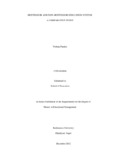
Please use this identifier to cite or link to this item:
https://hdl.handle.net/20.500.14301/204Full metadata record
| DC Field | Value | Language |
|---|---|---|
| dc.contributor.author | Pandey, Vishma | - |
| dc.date.accessioned | 2023-04-20T08:45:06Z | - |
| dc.date.available | 2023-04-20T08:45:06Z | - |
| dc.date.issued | 2012-12 | - |
| dc.identifier.citation | Pandey,V.(2012).Montessori and non- montessori education system: A comparative study | en_US |
| dc.identifier.uri | https://hdl.handle.net/20.500.14301/204 | - |
| dc.description.abstract | A typical Nepali society is comprised of diverse groups of people having different traditions, language, culture and economic status. Designing an appropriate education system and necessary environmental standard of teaching learning processes for all has been a challenging task for Nepal. At present, schools in the country can be broadly categorized as Government School, private Boarding School, Montessori School, Montessori-based School, Integrated School, etc. These schools are adopting several types of teaching methods and materials. Institutes with the tag of Montessori and flagged with the names such as Montessori International, Euro Kids, Kid Land Montessori and Montessori Kindergarten are booming in Kathmandu valley. However, to our best knowledge, there has been no comparative study of ECD education examining the methodological effectiveness and affordability. Thus, the present study makes in-depth comparative study of different types of methodologies currently in practice in different schools in the Kathmandu Metropolitan City area. More specially, a comprehensive comparative study of Montessori and Non-Montessori Education System Schools’ teaching methods and materials as well as the impacts of these ECD education systems are assessed in this study. For this, a qualitative research was conducted in the Kathmandu district including Montessori and non-Montessori schools located in Kalanki, Kalimati, Kuleshwor and Swayambhu. The research did an extended investigation focusing on three research questions while comparing the effectiveness of Montesssori and non Montessori education system and educational materials used in these education systems. ii I made a comparative study of Montessori and Non-montessori education with respect to a number of established theories and concepts focusing on philosophical bases, used materials, methods and ways of caring children. The overall research was conducted following a survey research design. The study population included teachers working in Montessori and Non-montessori schools of Kathmandu district and the selection of study samples out of this population was done using the snowball sampling technique. Altogether 18 respondents were selected representing three each Montessori schools and non Montessori schools of Kathmandu district. A set of guidelines for interview with principals, teachers and parents along with class and school observation forms were used to collect the necessary data. The guidelines were used in order to allow the research participants to keep their personnal views regarding the system of education in which they are working with. The findings of the study revealed that in both the Montessori and non Montessori schools childcare was the major focused component. In both types of schools, children were cared properly. There was the provision of ayah and teachers to take care of children in different activities. Both types of schools were applying various techniques and materials to make learning effective and joyful. However, Montessori teachers were more skillfull in these matters. The teaching learning in Montessori schools followed more practical methods than in the non-Montessori schools. The seat arrangement made in floor helped children in their free movement and taking part in different activities. The provision of desk and benches for children in non-Montessori schools limited children for a play-way method. There were more varieties of methods applied in teaching in Montessori schools than in non-Montessori schools. The teaching learning in iii Montessori schools was child centered whereas it was teacher centered in non Montessori schools. The teacher training was beneficial in children’s learning in both types of schools and both schools were aware of the importance of teacher training. But there was more access of teacher training in Montessori schools than in non-Montessori schools. Different types of materials were available in both types of schools. However, compared to Montessori schools, non-Montessori schools had limited number of materials for children as more emphasis was given on reading and writing. In respect of caring children, Montessori schools had enough ayahs and teachers to look after the children in different activities. The ratio of teacher and students was found more in non-montessori school perhaps that made a bit lacking in caring of children in non-Montessori schools. i | en_US |
| dc.language.iso | en | en_US |
| dc.title | MONTESSORI AND NON-MONTESSORI EDUCATION SYSTEM: A COMPARATIVE STUDY | en_US |
| dc.type | Dissertation | en_US |
| local.school.name | SOED | en_US |
| local.school.department | DOEL | en_US |
| local.school.program | M.Ed. in Early Childhood Development | en_US |
| local.school.level | Masters | en_US |
| Appears in Collections: | Disertation | |
Files in This Item:
| File | Description | Size | Format | |
|---|---|---|---|---|
| Vishma@Final Thesis@Jan18 - Copy.pdf | 971.64 kB | Adobe PDF |  View/Open |
Items in DSpace are protected by copyright, with all rights reserved, unless otherwise indicated.